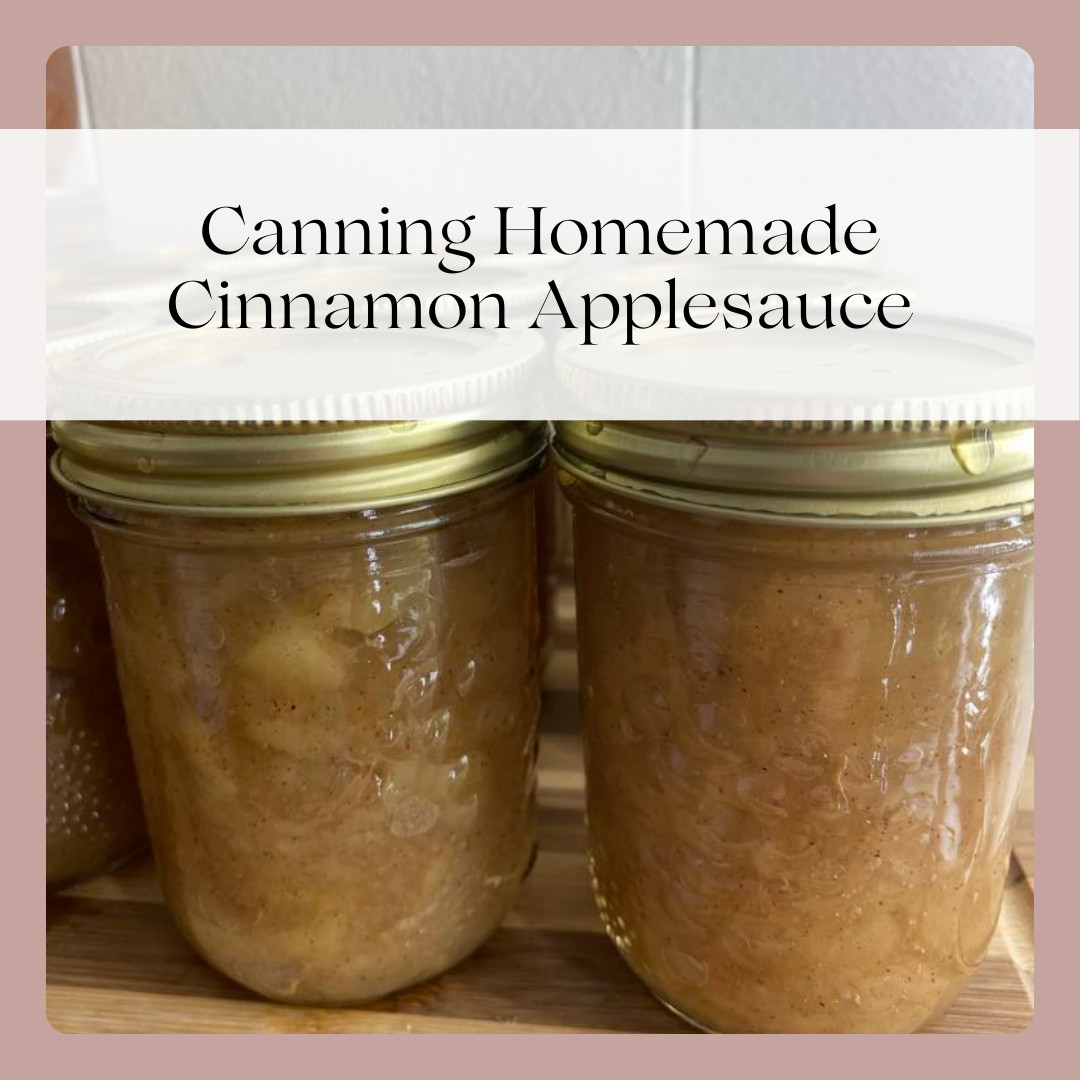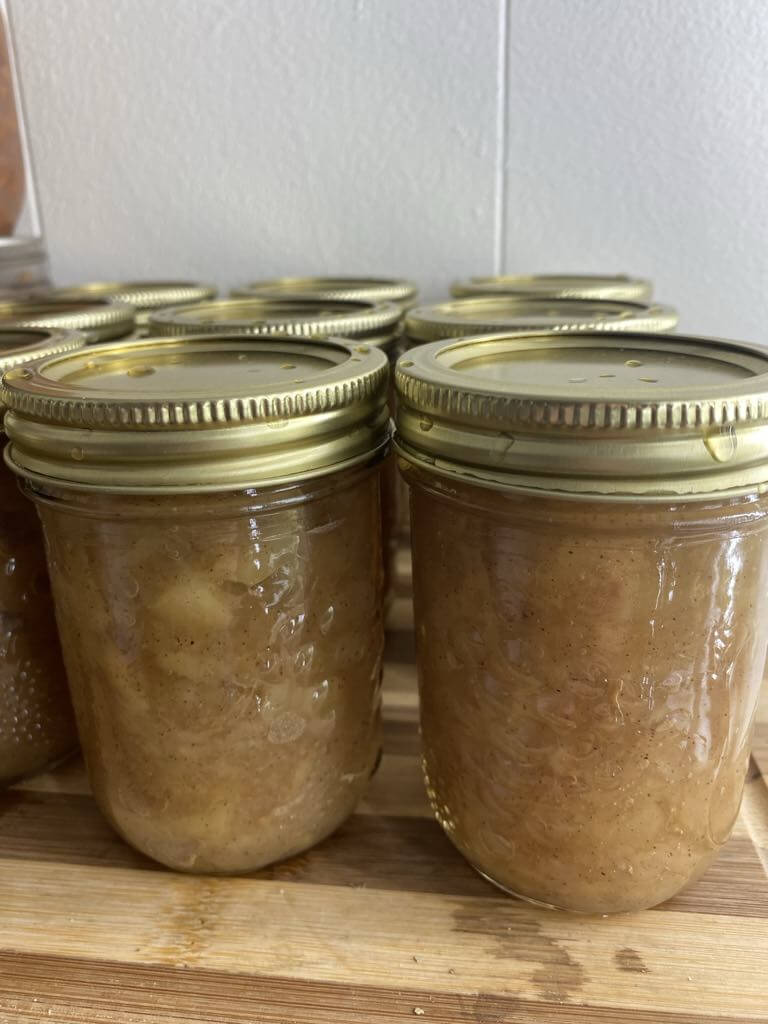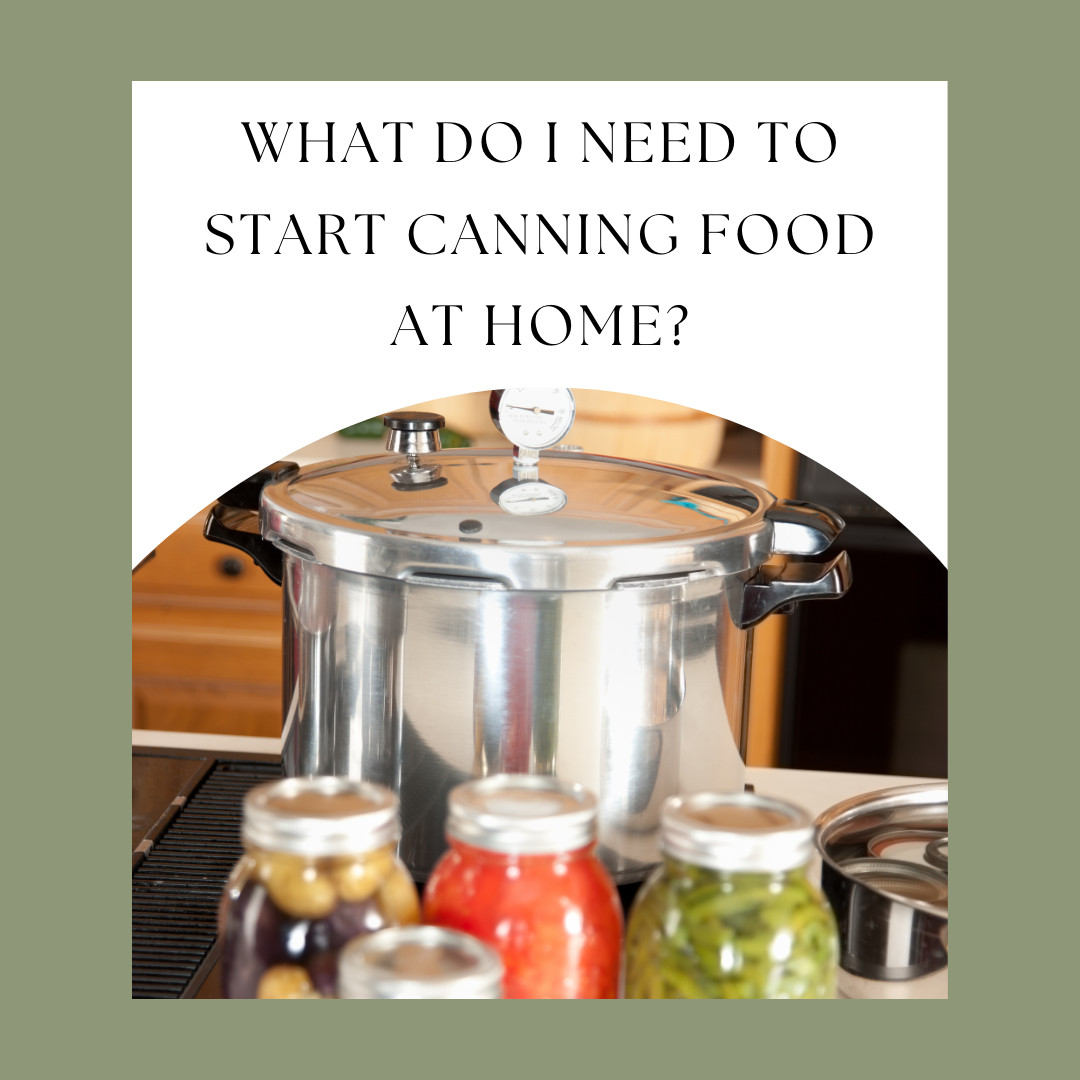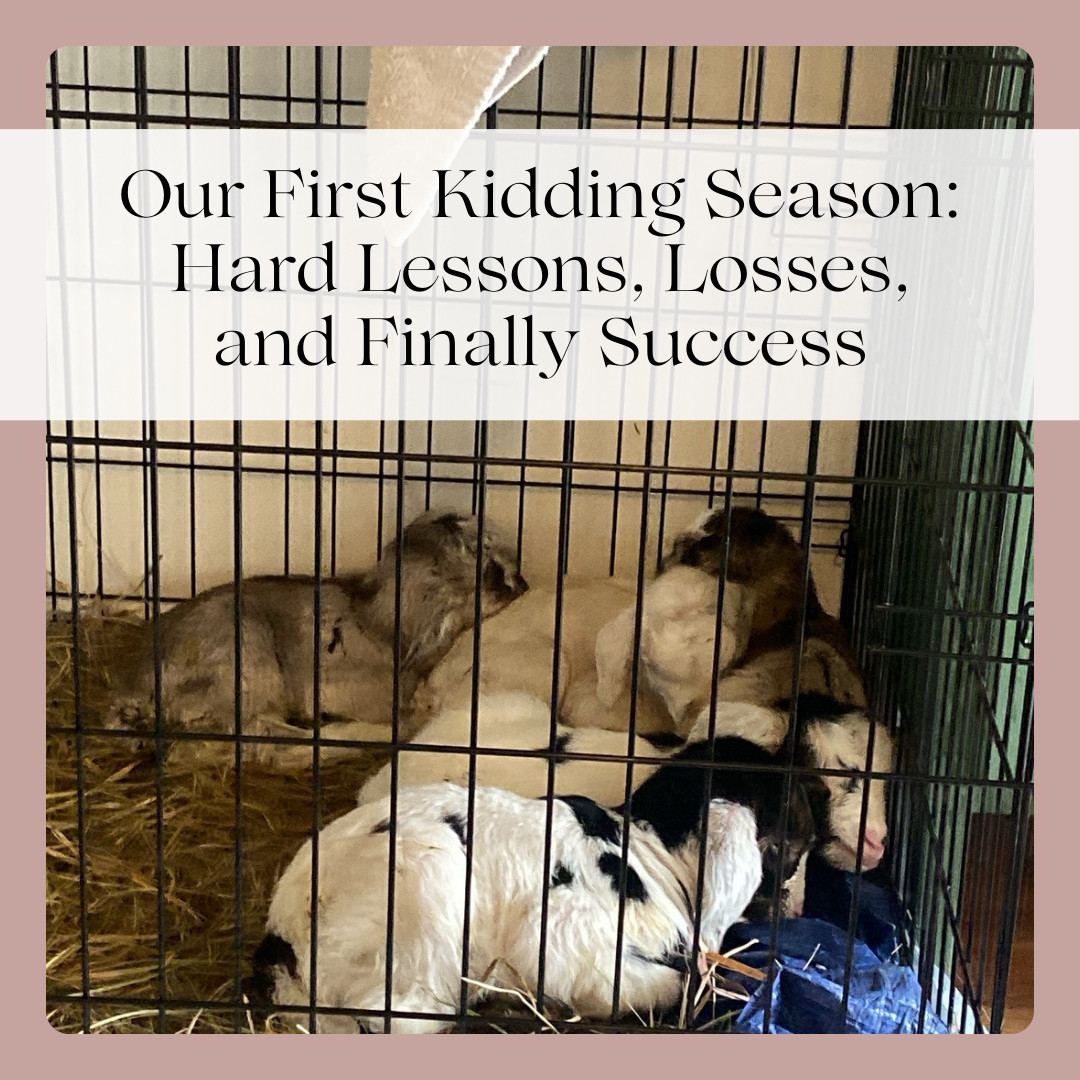
Homemade applesauce is a favorite in my family. So when we can get our hands on a lot of apples, it's one of my favorite things to make and preserve. I like to can the applesauce in 1/2 pint jars, perfect for one serving size to pack in lunches. Of course, we always have to have a little bowl of it freshly made too. It makes the house smell so good, we just can't resist!
First, the recipe for cinnamon applesauce. This recipe is for a small batch. I like to do 3x this recipe if I am just making it to eat (without canning). This gives us a few containers to stock up in the refrigerator. When I am canning, I like to do 6x the recipe.
Tip: Prepare jars, lids, and canner while applesauce is cooking to speed up the process.
Homemade Cinnamon Applesauce

Ingredients
- 2 pounds apples*, peeled and cut into 1-inch pieces
- 2/3 cups water
- 1/2 teaspoon cinnamon
- 1/8 teaspoon sea salt*
- 2-3 teaspoons raw honey
Instructions
- Combine all ingredients, except honey, in a 2-quart saucepan. Bring to a boil over medium-high heat. Cover, lower heat to medium. Cook for 20 minutes, or until apples are soft and are easy to mash.
- Remove pan from heat and allow to cool for about 15 min before removing lid.
- Stir in honey and mash apples to desired consistency.
Notes:
*I like to use a combination of apples, depending on how tart I want it. Our favorites are green, gala, and fuji
*I like to use himalayan or celtic salt
Now that you have your delicious applesauce made, if you have any leftover, it's time to can it for longterm storage. Keep the applesauce warm while you prepare for canning.
Steps for Water Bath Canning:
1. Prepare Your Jars and Lids
- Start by inspecting your jars for any cracks or chips. Only use those in perfect condition.
- Wash your jars in hot soapy water, or run them through a dishwasher cycle to sanitize them.
- Submerge the jars in your large pot filled with water, make sure you have the canning rack in the bottom of the pot. Bring the water to a simmer (not a full boil) and keep the jars hot until you’re ready to use them. This helps prevent cracking when adding hot food.
- Place the lids in a small saucepan of simmering water (do not boil) to soften the sealing compound.
2. Prepare the Recipe
If you haven't already made the applesauce, now is the time to get it started.
If you haven't already made the applesauce, now is the time to get it started.
3. Fill the Jars
- Remove one jar at a time from the simmering water, using your jar lifter. Pour out any water inside.
- Use a funnel to fill the jar with applesauce, leaving ½-inch headspace.
- Use a non-metallic spatula to remove any trapped air bubbles by gently sliding it down the sides of the jar.
- Wipe the rim of the jar with a clean, damp cloth dipped in vinegar to ensure a proper seal.
- Place a lid on the jar and screw on the band until fingertip-tight (don’t overtighten).
4. Process the Jars
- Once the jars are filled and sealed, place them on a canning rack inside your pot of boiling water. Make sure there’s at least 1-2 inches of water covering the jars. If you need to add more water, make sure it is hot water.
- Place the lid on the pot and bring the water to a rolling boil. If using a canner, do not use the pressure cap.
- Start timing once the water reaches a full boil.
Times: Half-Pint: 15 min
Pint: 20 min
Quart: 20 min - Also be sure you adjust times for your altitude.
5. Cool the Jars
- Once the processing time is complete, turn off the burner and remove the lid. DO NOT move the canner off of the burner.
- Let sit for 5 minutes, then carefully remove the jars using the jar lifter. Place them on a towel or wooden board, leaving space between jars.
- Allow to cool for 12–24 hours without touching the lids or bands. As the jars cool, you’ll hear the satisfying "ping" sound that indicates they’ve sealed.
6. Check the Seal
- After 24 hours, check the seals by pressing down on the center of each lid. If the lid does not pop back, it’s sealed. If it pops, you’ll need to refrigerate the jar and consume the contents within a week.
- Once sealed, remove the screw-on ring. You do not want to store the jars with the ring on because it can give you a false seal. If the jar is properly sealed, the lid will stay on until you open it.
7. Store and Enjoy
- Label your jars with the contents and the date. Store them in a cool, dark place. Properly sealed jars will last up to a year or more.
- When you open the sealed jar, use a ring to keep it closed.
- Refrigerate after opening.
A Note of Caution:
When it comes to canning, safety is key. It’s essential to only use approved canning recipes from trusted sources like the USDA, Ball, or other reputable food preservation organizations. These recipes have been tested to ensure they provide the right acidity levels and processing times to prevent the growth of harmful bacteria, particularly botulism, which thrives in low-acid, improperly canned foods. By following tested recipes, you’ll ensure that your canned goods are safe for your family to enjoy.
When it comes to canning, safety is key. It’s essential to only use approved canning recipes from trusted sources like the USDA, Ball, or other reputable food preservation organizations. These recipes have been tested to ensure they provide the right acidity levels and processing times to prevent the growth of harmful bacteria, particularly botulism, which thrives in low-acid, improperly canned foods. By following tested recipes, you’ll ensure that your canned goods are safe for your family to enjoy.
Happy Canning!
🌸 From my homestead heart to yours —
If you’re walking this same journey of homemaking, decluttering, and creating a peaceful, faith-filled home, you’re not alone.
I’d love to share encouragement, simple living inspiration, and homestead wisdom with you — right to your inbox.
If you’re walking this same journey of homemaking, decluttering, and creating a peaceful, faith-filled home, you’re not alone.
I’d love to share encouragement, simple living inspiration, and homestead wisdom with you — right to your inbox.
– Amanda | The HomeGrown Mom 🌾

Canning seems to be one of those long-lost skills that is making it's way back into homes again. Yes, some have continued to do it. But with homesteading on the rise, there are so many who have never canned and didn't grow up with it either. I have been canning, off and on, for almost 15 years. It was a necessity due to some of my daughter's special dietary needs. For the past year or 2 I have been canning more regularly and it's such a great feeling when I open up my pantry and see all of my home-canned goods. Not only do I know exactly what is in each jar, but it's also a nice feeling to know that I am contributing to my family's health and that we don't have to rely on other people/stores for our food.
Now, let's talk about water bath canning. It is an excellent option for high-acid foods such as fruits, jams, jellies, and pickles. It’s easy to master and doesn’t require any fancy equipment beyond a large pot and a few canning supplies. In this post, I’ll walk you through the steps for water bath canning. Two of my favorites to can are applesauce and pear or apple slices. I'll be sharing those recipes soon!
What is Water Bath Canning?
Water bath canning is a method used for preserving high-acid foods by submerging jars in boiling water for a specified amount of time. The heat forces air out of the jars, creates a vacuum seal, and destroys mold, yeast, and bacteria that could cause spoilage.
Equipment You’ll Need:
- A large pot with a lid (canner or a deep stockpot)
- Canning rack (or something to keep jars off the bottom of the pot)
- Canning jars with lids and bands
- Jar lifter
- Ladle and funnel
- Towels and cloths for wiping jars
- Non-metallic spatula for removing air bubbles
- Labels for marking contents and date
*Most of your canning supplies can be found in a set like this: Canning Supplies Starter Kit - be sure you check measurements to ensure that the canning rack fits into you stockpot or canner.
Steps for Water Bath Canning:
1. Prepare Your Jars and Lids
- Start by inspecting your jars for any cracks or chips. Only use those in perfect condition.
- Wash your jars in hot soapy water, or run them through a dishwasher cycle to sanitize them.
- Submerge the jars in your large pot filled with water, make sure you have the canning rack in the bottom of the pot. Bring the water to a simmer (not a full boil) and keep the jars hot until you’re ready to use them. This helps prevent cracking when adding hot food.
- Place the lids in a small saucepan of simmering water (do not boil) to soften the sealing compound.
2. Prepare the Recipe
Make sure whatever you are canning is made and ready to go before you start the canning process. Some items, like applesauce, can be cooking while you prep your canner and bring it up to the proper heat.
Make sure whatever you are canning is made and ready to go before you start the canning process. Some items, like applesauce, can be cooking while you prep your canner and bring it up to the proper heat.
3. Fill the Jars
- Remove one jar at a time from the simmering water, using your jar lifter. Pour out any water inside.
- Use a funnel to fill the jar with your prepared food, leaving the appropriate headspace (usually 1/2 inch for fruits).
- Use a non-metallic spatula to remove any trapped air bubbles by gently sliding it down the sides of the jar.
- Wipe the rim of the jar with a clean, damp cloth dipped in vinegar to ensure a proper seal.
- Place a lid on the jar and screw on the band until fingertip-tight (don’t overtighten).
4. Process the Jars
- Once the jars are filled and sealed, place them on a canning rack inside your pot of boiling water. Make sure there’s at least 1-2 inches of water covering the jars. If you need to add more water, make sure it is hot water.
- Place the lid on the pot and bring the water to a rolling boil. If using a canner, do not use the pressure cap.
- Start timing once the water reaches a full boil. Most fruit recipes require 20–30 minutes of processing, but always refer to your recipe for exact times.
- Also be sure you adjust times for your altitude.
5. Cool the Jars
- Once the processing time is complete, turn off the burner and remove the lid. DO NOT move the canner off of the burner.
- Let sit for 5 minutes, then carefully remove the jars using the jar lifter. Place them on a towel or wooden board, leaving space between jars.
- Allow to cool for 12–24 hours without touching the lids or bands. As the jars cool, you’ll hear the satisfying "ping" sound that indicates they’ve sealed.
6. Check the Seal
- After 24 hours, check the seals by pressing down on the center of each lid. If the lid does not pop back, it’s sealed. If it pops, you’ll need to refrigerate the jar and consume the contents within a week.
- Once sealed, remove the screw-on ring. You do not want to store the jars with the ring on because it can give you a false seal. If the jar is properly sealed, the lid will stay on until you open it.
7. Store and Enjoy
- Label your jars with the contents and the date. Store them in a cool, dark place. Properly sealed jars will last up to a year or more.
- When you open the sealed jar, use a ring to keep it closed.
- Refrigerate after opening.
A Note of Caution:
When it comes to canning, safety is key. It’s essential to only use approved canning recipes from trusted sources like the USDA, Ball, or other reputable food preservation organizations. These recipes have been tested to ensure they provide the right acidity levels and processing times to prevent the growth of harmful bacteria, particularly botulism, which thrives in low-acid, improperly canned foods. By following tested recipes, you’ll ensure that your canned goods are safe for your family to enjoy.
When it comes to canning, safety is key. It’s essential to only use approved canning recipes from trusted sources like the USDA, Ball, or other reputable food preservation organizations. These recipes have been tested to ensure they provide the right acidity levels and processing times to prevent the growth of harmful bacteria, particularly botulism, which thrives in low-acid, improperly canned foods. By following tested recipes, you’ll ensure that your canned goods are safe for your family to enjoy.
Happy Canning!
🌸 From my homestead heart to yours —
If you’re walking this same journey of homemaking, decluttering, and creating a peaceful, faith-filled home, you’re not alone.
I’d love to share encouragement, simple living inspiration, and homestead wisdom with you — right to your inbox.
If you’re walking this same journey of homemaking, decluttering, and creating a peaceful, faith-filled home, you’re not alone.
I’d love to share encouragement, simple living inspiration, and homestead wisdom with you — right to your inbox.
– Amanda | The HomeGrown Mom 🌾

In order to save time and money, I like to buy foods in bulk. One of the items I like to buy in bulk is rice. I usually get it from Sams in either a 25 or 50 pound bag. Before I go any further, let me state that I have not done the proper research to know exactly which rice is the healthiest and best for my family. For now, this is just a budget-friendly option that I choose.
As you can imagine, this large of a bag takes my family a few months to go through (we use a lot of rice!). I usually bag it into gallon size bags and freeze it until I'm ready to use it. This time I decided to use my air-tight sealer and some half-gallon jars I had on hand. I kept one jar open for use and sealed another 7 jars. I dated the top and will store these in my pantry.
Again, I haven't done a ton of research on this option. I have seen that you can just simply seal them without any oxygen absorbers. This should keep the bugs and pests out and also help it remain fresh. However, for super long-term storage (like 10+ years), I think I'd prefer to add the oxygen absorbers for that extra bit of preservation.
Here are the supplies I used (other than the rice):
Vacuum Sealer - this is just a generic link. My sealer is so old it is no longer available. It is a Black & Decker brand. Just be sure the sealer you use has an way to hook up an external hose for jar sealing.
Oxygen Absorbers (optional)
There really isn't much to it. Just fill the jars with a little bit of head space. Attach the hose to the sealer, put the lid onto the jar, place the sealer firmly on top, and hit the seal button. Once the seal is completed, I have found it best to disconnect the hose first, then remove the top (what fits over the lid) off of the jar. Otherwise, the top seems to want to undo the seal and take the lid with it. This doesn't happen every time, but when I remove the hose first, it almost never happens.
Then, just remember to store the jars in a cool, dark place.
This post is where I got my information for getting started. It states to either air-tight seal or use the oxygen absorbers. It also gives tips on proper storage.
Happy Storing!
🌸 From my homestead heart to yours —
If you’re walking this same journey of homemaking, decluttering, and creating a peaceful, faith-filled home, you’re not alone.
I’d love to share encouragement, simple living inspiration, and homestead wisdom with you — right to your inbox.
If you’re walking this same journey of homemaking, decluttering, and creating a peaceful, faith-filled home, you’re not alone.
I’d love to share encouragement, simple living inspiration, and homestead wisdom with you — right to your inbox.
– Amanda | The HomeGrown Mom 🌾

Canning at home can seem like a daunting task, especially if you've never done it before or didn't grow up in a household where canning was a regular activity. The process requires a bit of courage and the right equipment to start preserving your own foods safely and effectively. From personal experience, the journey to mastering home canning can stem from necessity, such as the need to control dietary restrictions, and morph into a rewarding hobby that offers both satisfaction and a plethora of homemade goods.
To begin canning, certain tools are indispensable. These include a quality canner that can accommodate both water bath and pressure canning methods, canning jars along with new lids and rings, essential canning tools like a funnel, jar lifter, and bubble remover, and labels to ensure everything is clearly marked with contents and date processed. It's essential to ensure that jars are free from nicks or cracks and that lids have an intact seal to ensure the safety and longevity of the canned goods.
Lastly, proper storage and adherence to approved canning recipes are crucial to the success and safety of your canning endeavors. Canned goods should be kept in a dark, cool place like a pantry, and older items should be used first to maintain freshness. By utilizing only approved and tested recipes, you safeguard against the potential risks of foodborne illnesses, ensuring that your home-canned foods are not only delicious but safe to consume. This beginning guide underscores the importance of preparation, quality supplies, and following safety guidelines to embark on your own canning journey.
Read more...
Creating nutritious meals from scratch starts with a well-stocked pantry, focusing on several key categories. Grains and dried legumes, such as wheat, oats, and rice, offer a versatile base for various dishes, from baked goods to soups and main courses. Fats and oils, including high-quality olive oil, coconut oil, and butter, are essential for adding flavor and nutritional value. Natural sweeteners like honey, maple syrup, and molasses provide healthier alternatives to refined sugars, enhancing the flavor profile of homemade treats.
For those embarking on the journey of cooking and baking from scratch, maintaining a pantry filled with baking staples, meats and proteins, and a variety of fruits and vegetables is crucial. Ingredients such as baking powder, baking soda, yeast, and dried herbs and spices are indispensable. Seasonal fruits and vegetables enrich meals with optimal nutrition and flavor, while a stock of meats and proteins ensures a robust meal plan. Preserving these items allows for year-round enjoyment and convenience.
Incorporating convenience and comfort foods into the pantry ensures a balance between homemade meals and practicality for busy days. Canned goods, broth, and frozen vegetables simplify meal preparation without compromising quality. Meanwhile, stocking up on ingredients for comforting dishes like homemade soup, cookies, or bread provides nourishment and solace. A strategy of buying in bulk, preserving foods, and rotating stock ensures a pantry that supports healthy, homemade meals while minimizing waste.
Read more...

















